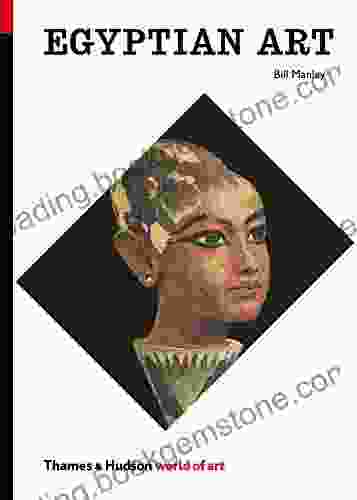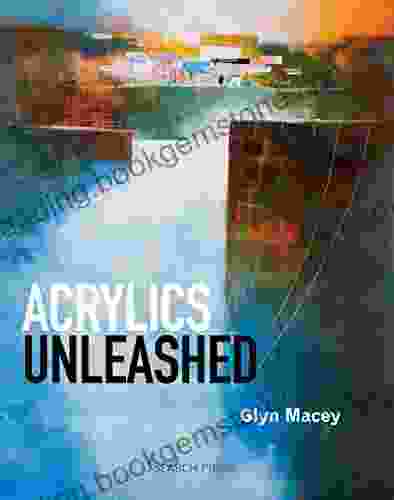Unveiling the Enchanting World of Egyptian Art: A Journey Through History and Craftsmanship

In the annals of art history, few civilizations have left an imprint as profound and enduring as the ancient Egyptians. From the colossal pyramids that pierce the desert sky to the intricately inscribed hieroglyphs that adorned temples and tombs, Egyptian art stands as a testament to the ingenuity and artistry of a civilization that flourished for over three millennia.
This article will delve into the captivating world of Egyptian art, exploring its rich history, diverse forms, and enduring legacy. We will uncover the vibrant colors and intricate designs that characterized Egyptian paintings, the monumental sculptures that guarded temples and palaces, and the exquisite jewelry that adorned pharaohs and commoners alike.
4.1 out of 5
| Language | : | English |
| File size | : | 147961 KB |
| Text-to-Speech | : | Enabled |
| Screen Reader | : | Supported |
| Enhanced typesetting | : | Enabled |
| Print length | : | 320 pages |
The Palette of Ancient Egypt
Egyptian artists possessed a vibrant palette of colors, expertly crafted from natural pigments. The bright blue of lapis lazuli, the deep green of malachite, and the rich red of ochre were among the most commonly used hues. These colors were not merely decorative; they carried symbolic meanings that permeated Egyptian culture.
Blue, the color of the sky and the Nile River, was associated with life, fertility, and rebirth. Green, representing vegetation and growth, symbolized prosperity and abundance. Red, the color of blood and the desert, was associated with power, strength, and protection.
The Art of Hieroglyphics
Hieroglyphs, the ancient Egyptian writing system, were not merely a means of communication but also a form of artistic expression. Each hieroglyph represented a sound, a syllable, or an entire word, and they were combined to create intricate texts that adorned everything from temple walls to funerary stelae.
The hieroglyphs themselves were often elaborate and stylized, incorporating human figures, animals, and plants. The skilled scribes who mastered this complex writing system were highly respected and held a prestigious position in Egyptian society.
Monumental Architecture
The pyramids of Giza are perhaps the most iconic examples of Egyptian monumental architecture. These colossal structures, built as tombs for the pharaohs, showcase the engineering prowess and architectural ingenuity of the ancient Egyptians.
The pyramids were constructed with precision, using massive blocks of stone quarried from nearby. The interiors were adorned with intricate carvings and paintings, depicting scenes from the pharaoh's life and offering prayers to the gods.
In addition to the pyramids, Egyptian architects also designed and built magnificent temples, palaces, and tombs. These structures were often decorated with reliefs and statues, showcasing the power and wealth of the pharaohs who commissioned them.
Exquisite Sculptures
Egyptian sculptors possessed an extraordinary ability to capture the human form and express emotions through stone. Their sculptures ranged from colossal statues of pharaohs to delicate figurines of everyday objects.
The most common material used for sculptures was limestone, which was relatively soft and easy to carve. However, sculptors also worked with harder materials such as granite, sandstone, and basalt.
Egyptian sculptures were often idealized, with perfect proportions and idealized features. However, they could also be highly realistic, capturing the unique characteristics of individuals and the emotions they experienced.
Colorful Paintings
Egyptian paintings were vibrant and full of life, depicting scenes from daily life, religious ceremonies, and mythological stories. They were typically created on papyrus, a paper-like material made from the stems of the papyrus plant.
The colors used in Egyptian paintings were similar to those used in hieroglyphs, with blue, green, red, yellow, black, and white being the most common. Artists used a tempera technique, mixing pigments with water and egg yolk to create a durable and long-lasting paint.
Egyptian paintings often followed strict conventions, with figures depicted in profile and with limited perspective. However, they also exhibited a remarkable degree of detail and expressiveness.
Exquisite Jewelry
Jewelry played an important role in Egyptian society, serving both as adornment and as a symbol of status and wealth. Egyptians crafted exquisite jewelry from a variety of materials, including gold, silver, turquoise, lapis lazuli, and carnelian.
Egyptian jewelry was often intricate and elaborate, featuring detailed designs and finely worked gemstones. Necklaces, earrings, bracelets, and rings were among the most common types of jewelry worn by both men and women.
In addition to its aesthetic value, Egyptian jewelry also had religious significance. Many pieces were adorned with protective symbols and amulets, designed to ward off evil spirits and bring good fortune to the wearer.
The Legacy of Egyptian Art
The art of ancient Egypt has had a profound and enduring impact on world culture. Its vibrant colors, intricate designs, and monumental architecture have inspired artists and architects for centuries.
Egyptian motifs can be found in art from around the world, from ancient Greek and Roman art to modern-day paintings and sculptures. The pyramids of Giza remain one of the most iconic landmarks in the world, attracting millions of visitors each year.
The legacy of Egyptian art is a testament to the enduring power of human creativity and the ability of art to transcend time and culture. It is a legacy that continues to inspire and amaze people around the world.
The art of ancient Egypt is a captivating and multifaceted expression of a civilization that achieved remarkable heights of cultural and artistic achievement. From the vibrant colors of its paintings to the monumental grandeur of its architecture, Egyptian art has left an indelible mark on the world.
By exploring the rich history, diverse forms, and enduring legacy of Egyptian art, we can gain a deeper appreciation for the ingenuity and artistry of a civilization that has forever shaped the course of human history.
4.1 out of 5
| Language | : | English |
| File size | : | 147961 KB |
| Text-to-Speech | : | Enabled |
| Screen Reader | : | Supported |
| Enhanced typesetting | : | Enabled |
| Print length | : | 320 pages |
Do you want to contribute by writing guest posts on this blog?
Please contact us and send us a resume of previous articles that you have written.
 Best Book
Best Book Page Flip
Page Flip Bookshelf
Bookshelf Literary loom
Literary loom Chapter
Chapter Bookish
Bookish PageTurner
PageTurner Bibliophile
Bibliophile Story
Story Inkwell
Inkwell Bookworm
Bookworm Labyrinth
Labyrinth Plot Twist
Plot Twist Prose
Prose Paperback
Paperback Storyteller
Storyteller Sanctuary
Sanctuary Fiction
Fiction Reading
Reading Chronicle
Chronicle Read
Read Jeffrey Spivak
Jeffrey Spivak Nicki Grace
Nicki Grace Yahtzee Croshaw
Yahtzee Croshaw Rian Hughes
Rian Hughes Lynsey Addario
Lynsey Addario Jessica Lee
Jessica Lee N Dia Rae
N Dia Rae Mark Christopher Weber
Mark Christopher Weber Sara Barnes
Sara Barnes Hans Keilson
Hans Keilson Franklyn Griffiths
Franklyn Griffiths Albert Corbeto
Albert Corbeto Ted Okuda
Ted Okuda Adele Wagstaff
Adele Wagstaff 3rd Edition Kindle Edition
3rd Edition Kindle Edition Nancy Marguerite Anderson
Nancy Marguerite Anderson Ed Miller
Ed Miller Alecia J
Alecia J John Ingledew
John Ingledew David Morrell
David Morrell Bart Rulon
Bart Rulon Harry Thurston
Harry Thurston Ava Reid
Ava Reid Pam Cook
Pam Cook Donna Digiuseppe
Donna Digiuseppe Robin Meloy Goldsby
Robin Meloy Goldsby Troy Taylor
Troy Taylor John Phillip Santos
John Phillip Santos Matthew Bourne
Matthew Bourne Amy Latta
Amy Latta Adrien Clautrier
Adrien Clautrier A J Markam
A J Markam Alex Danchev
Alex Danchev John Perrier
John Perrier Agatha Christie
Agatha Christie Eric Goldberg
Eric Goldberg Geronimo
Geronimo Matt Dickinson
Matt Dickinson Claudia Rankine
Claudia Rankine Alex Kerr
Alex Kerr A K Duboff
A K Duboff Craig Johnson
Craig Johnson Faith Hunter
Faith Hunter Neil Wilson
Neil Wilson My Daily Spanish
My Daily Spanish Rachael Cerrotti
Rachael Cerrotti Stephen Davis
Stephen Davis E C Godhand
E C Godhand Alan Jacobson
Alan Jacobson Alan Veale
Alan Veale Haroon Moghul
Haroon Moghul Stefan Zweig
Stefan Zweig Hayley Mills
Hayley Mills Rosa Park
Rosa Park Scott Harwood
Scott Harwood Alejandra Viscarra
Alejandra Viscarra Dale Olausen
Dale Olausen Juhea Kim
Juhea Kim Glyn Macey
Glyn Macey Randy Palmer
Randy Palmer Gregory Benford
Gregory Benford Bobby Love
Bobby Love Aki Choklat
Aki Choklat Afia Atakora
Afia Atakora Inman Learning
Inman Learning Kathleen Brady
Kathleen Brady Michael Anderson
Michael Anderson Albert Samaha
Albert Samaha Danny Newman
Danny Newman Anne Macleod
Anne Macleod Brad Thor
Brad Thor Max Eisen
Max Eisen Judith M Heimann
Judith M Heimann Armond T Joyce
Armond T Joyce Viola Shipman
Viola Shipman Kirsten Weiss
Kirsten Weiss Eddie R Hicks
Eddie R Hicks Mary Brooks Picken
Mary Brooks Picken Lee Craker
Lee Craker Frank Catalano
Frank Catalano Ben D Over
Ben D Over Terry Barrett
Terry Barrett Christopher G Nuttall
Christopher G Nuttall Anthony Doerr
Anthony Doerr Alan Laycock
Alan Laycock Alex Foster
Alex Foster Jack Anderson
Jack Anderson Richard Hunt
Richard Hunt Alfons Kaiser
Alfons Kaiser Chloe Garner
Chloe Garner Peter Gethers
Peter Gethers Linda Bloomfield
Linda Bloomfield Nancy Beiman
Nancy Beiman Soon Y Warren
Soon Y Warren Jeff Lieberman
Jeff Lieberman Fiona Maccarthy
Fiona Maccarthy Adrian Tchaikovsky
Adrian Tchaikovsky J R R Tolkien
J R R Tolkien Ramy Vance
Ramy Vance Aleksandar Hemon
Aleksandar Hemon Nancy Milford
Nancy Milford Daniel Kay Hertz
Daniel Kay Hertz Cecil Jenkins
Cecil Jenkins Francisco Martin Rayo
Francisco Martin Rayo Bill Manley
Bill Manley Aeham Ahmad
Aeham Ahmad Hob Osterlund
Hob Osterlund Azalea Ellis
Azalea Ellis Sandie Heron
Sandie Heron Susan Evenson
Susan Evenson Gerald L Kooyman
Gerald L Kooyman Amy Tan
Amy Tan Howexpert Press
Howexpert Press Ivy Mix
Ivy Mix Naughty Dog
Naughty Dog Abdul El Sayed
Abdul El Sayed Alex Jennings
Alex Jennings John Gold
John Gold Roberto Lovato
Roberto Lovato William C Meadows
William C Meadows Alex Dudok De Wit
Alex Dudok De Wit Ak Turner
Ak Turner Michael Connelly
Michael Connelly Anais Granofsky
Anais Granofsky Tamara Thiessen
Tamara Thiessen Adrian Dater
Adrian Dater Simon Callow
Simon Callow Alastair Reynolds
Alastair Reynolds Alexa Martin
Alexa Martin Ajax Lygan
Ajax Lygan James S A Corey
James S A Corey Mary Karr
Mary Karr Aer Ki Jyr
Aer Ki Jyr Bernard Cornwell
Bernard Cornwell William Golding
William Golding Katja Schmitt
Katja Schmitt F Sehnaz Bac
F Sehnaz Bac George Smith
George Smith Aimee Nezhukumatathil
Aimee Nezhukumatathil Elizabeth Holmes
Elizabeth Holmes Margaret Mitchell
Margaret Mitchell Despina Stratigakos
Despina Stratigakos Brien Foerster
Brien Foerster Georgia Purdom
Georgia Purdom Tracy Michaud
Tracy Michaud Ninni Holmqvist
Ninni Holmqvist Akiva Teddy Macleod
Akiva Teddy Macleod Scott Bukatman
Scott Bukatman Mary Ann Shaffer
Mary Ann Shaffer Alex Tizon
Alex Tizon Roxana Robinson
Roxana Robinson Roland Nyns
Roland Nyns Rudy Rucker
Rudy Rucker Dave Cornthwaite
Dave Cornthwaite Rocio Carvajal
Rocio Carvajal Eileen Sorg
Eileen Sorg Graham Mcneill
Graham Mcneill Alan Bachmann
Alan Bachmann Bernard Diederich
Bernard Diederich Julian Bell
Julian Bell Paul Austin
Paul Austin Alexa West
Alexa West Tom Swimm
Tom Swimm Robyn Blakeman
Robyn Blakeman Michael Reyes
Michael Reyes Peter Burke
Peter Burke Geert Mak
Geert Mak Alejandro Jodorowsky
Alejandro Jodorowsky Adrien Gombeaud
Adrien Gombeaud Jason Cordova
Jason Cordova Rob Stone
Rob Stone St Paul S Greek Orthodox Church
St Paul S Greek Orthodox Church Frances Kai Hwa Wang
Frances Kai Hwa Wang Anita Friedman
Anita Friedman George Bernard Shaw
George Bernard Shaw A J Alonzo Wind
A J Alonzo Wind Anne Vipond
Anne Vipond Sjeng Scheijen
Sjeng Scheijen Andy Steves
Andy Steves Robert Arp
Robert Arp Albert Woodfox
Albert Woodfox Joseph Campbell
Joseph Campbell Alex Gough
Alex Gough Matthew Reilly
Matthew Reilly Greg Sestero
Greg Sestero Anne Thomas Soffee
Anne Thomas Soffee Alex Moore
Alex Moore Osman Yousefzada
Osman Yousefzada Ntozake Shange
Ntozake Shange Jim Hinckley
Jim Hinckley Natasha Boyd
Natasha Boyd Alan Smith
Alan Smith Philip Norman
Philip Norman Mary Monroe
Mary Monroe Rozsika Parker
Rozsika Parker Robert M Kerns
Robert M Kerns Fanny Kelly
Fanny Kelly Candida R Moss
Candida R Moss Alberlin Torres
Alberlin Torres Richard Poulin
Richard Poulin Alicia Drake
Alicia Drake Laurieann Gibson
Laurieann Gibson Alastair Campbell
Alastair Campbell Erika Hecht
Erika Hecht Alex Berenson
Alex Berenson Fluent In Korean
Fluent In Korean Geoff Hann
Geoff Hann Laurie Birnsteel
Laurie Birnsteel M Osman Siddique
M Osman Siddique Alan Carr
Alan Carr Jeanne Filler Scott
Jeanne Filler Scott Charles De Lint
Charles De Lint Andrew Morton
Andrew Morton Mariusz Krukowski
Mariusz Krukowski Gary Jennings
Gary Jennings Jack L Grossman
Jack L Grossman Alex Hibbert
Alex Hibbert Martin Edge
Martin Edge Al Saadiq Banks
Al Saadiq Banks Adam Roberts
Adam Roberts Betty Reid Soskin
Betty Reid Soskin Thomas Huhti
Thomas Huhti Smashing Magazine
Smashing Magazine Massoud Hayoun
Massoud Hayoun Jennifer Egan
Jennifer Egan Patrick J Flannigan
Patrick J Flannigan Cheech Marin
Cheech Marin Amanda Lawrence
Amanda Lawrence Alan Grainger
Alan Grainger Huma Abedin
Huma Abedin Samantha Downing
Samantha Downing Kerry Trout
Kerry Trout Geninne Zlatkis
Geninne Zlatkis Peter Samuel
Peter Samuel Torben Landskrone
Torben Landskrone Robert Byron
Robert Byron Kayleigh Mcenany
Kayleigh Mcenany Karl Beecher
Karl Beecher Eric Sprinkle
Eric Sprinkle Fadel Abuelula
Fadel Abuelula Julie Collins
Julie Collins Stuart Thornton
Stuart Thornton Elizabeth Mcpherson
Elizabeth Mcpherson Alex Kotlowitz
Alex Kotlowitz David Conyers
David Conyers P T Books
P T Books Akaisha Kaderli
Akaisha Kaderli Sarah Crafts
Sarah Crafts Jennifer Lilya
Jennifer Lilya Tod Benoit
Tod Benoit Heidi Moksnes
Heidi Moksnes Lon Varnadore
Lon Varnadore Noam Oswin
Noam Oswin Aleksandar Nedeljkovic
Aleksandar Nedeljkovic Bradley Wright
Bradley Wright Richard Doetsch
Richard Doetsch Antonio Centeno
Antonio Centeno Alan Rabinowitz
Alan Rabinowitz Marian Filar
Marian Filar Cherrie Moraga
Cherrie Moraga Cassia Cogger
Cassia Cogger Amanda Gorman
Amanda Gorman Christian Cameron
Christian Cameron Robert Clark
Robert Clark Ann Maclean
Ann Maclean K J Gillenwater
K J Gillenwater Allison Moore
Allison Moore Garret Romaine
Garret Romaine Jennifer Sewing
Jennifer Sewing Aimee Alexander
Aimee Alexander Ella Blake
Ella Blake Cynthia D Yoder
Cynthia D Yoder Josh Holliday
Josh Holliday Akira Kurosawa
Akira Kurosawa Tim Bonyhady
Tim Bonyhady Robert Condon
Robert Condon Matt Ortile
Matt Ortile Kim E Nielsen
Kim E Nielsen C M Carney
C M Carney Alex Hillkurtz
Alex Hillkurtz Greg Jenkins
Greg Jenkins Lavonne Mueller
Lavonne Mueller Grace Lees Maffei
Grace Lees Maffei Akwaeke Emezi
Akwaeke Emezi Barbara Brownie
Barbara Brownie Alastair Vere Nicoll
Alastair Vere Nicoll Danielle Donaldson
Danielle Donaldson John French
John French John Gonzalez
John Gonzalez Abdulrazak Gurnah
Abdulrazak Gurnah Gail Pool
Gail Pool Alan Murphy
Alan Murphy Alex Zadeh
Alex Zadeh Wes Mcdowell
Wes Mcdowell Alex White
Alex White Alan Verskin
Alan Verskin Gerhard Haase Hindenberg
Gerhard Haase Hindenberg Fiona Humberstone
Fiona Humberstone Samuel R Delany
Samuel R Delany Ken Layne
Ken Layne Harlow Robinson
Harlow Robinson Masahiro Kasahara
Masahiro Kasahara Gregory Michie
Gregory Michie Maturin Murray Ballou
Maturin Murray Ballou Alda Sigmundsdottir
Alda Sigmundsdottir John Maloof
John Maloof Alan M Davis
Alan M Davis Peter Carey
Peter Carey A D Davies
A D Davies Tom Wood
Tom Wood A J Liebling
A J Liebling Don Yaeger
Don Yaeger C M Muller
C M Muller J D Adams
J D Adams Irmgard Bartenieff
Irmgard Bartenieff Afua Hirsch
Afua Hirsch Anne Glenconner
Anne Glenconner Alain Kerzoncuf
Alain Kerzoncuf Akiko Busch
Akiko Busch Diane Mierzwik
Diane Mierzwik Keila Rowe
Keila Rowe Tim Lawrence
Tim Lawrence Danie Ware
Danie Ware Rich Polanco
Rich Polanco Michael Sayman
Michael Sayman Alex Kava
Alex Kava Joan Druett
Joan Druett A E Filby
A E Filby Alan Colquhoun
Alan Colquhoun Jane Patrick
Jane Patrick Tara Ellis
Tara Ellis Dima Ghawi
Dima Ghawi Herman Melville
Herman Melville Felix R Savage
Felix R Savage Christopher P Jones
Christopher P Jones G J Ogden
G J Ogden Arlene Croce
Arlene Croce Stephen Bodio
Stephen Bodio Charlene Tarbox
Charlene Tarbox Jeffery H Haskell
Jeffery H Haskell Lauren D Schmalz
Lauren D Schmalz Kimiko Kitani
Kimiko Kitani J Pal
J Pal Dominique Dupuy
Dominique Dupuy Aisha Sabatini Sloan
Aisha Sabatini Sloan Adam Nayman
Adam Nayman Siddharth Anbalagan
Siddharth Anbalagan Paul J Pastor
Paul J Pastor D Rus
D Rus Shelli Marie
Shelli Marie Ann Mah
Ann Mah Gary Zacny
Gary Zacny Peter Warner
Peter Warner Giovanni Iannoni
Giovanni Iannoni Lama Rod Owens
Lama Rod Owens Katie Daisy
Katie Daisy Reshonda Tate Billingsley
Reshonda Tate Billingsley Rachel Mcmillan
Rachel Mcmillan Junheng Li
Junheng Li Kazuaki Tanahashi
Kazuaki Tanahashi Roger Bennett
Roger Bennett Paul Hallas
Paul Hallas Jack Jewers
Jack Jewers Dave Addey
Dave Addey Albert Blasco Peris
Albert Blasco Peris Living Languages
Living Languages Alex Albrinck
Alex Albrinck Lawrence F Lihosit
Lawrence F Lihosit Alan Maimon
Alan Maimon Brenda Barrett
Brenda Barrett Heather Hutchison
Heather Hutchison Laurie Schneider Adams
Laurie Schneider Adams Thomas Geve
Thomas Geve Charles Chipiez
Charles Chipiez Magunta Dayakar
Magunta Dayakar Michael Booth
Michael Booth Sean Hall
Sean Hall C N Phillips
C N Phillips Shaul Kelner
Shaul Kelner Rhonda K Garelick
Rhonda K Garelick Ella Frances Sanders
Ella Frances Sanders Tom Dunkel
Tom Dunkel Mia P Manansala
Mia P Manansala Alistair Urquhart
Alistair Urquhart Chimamanda Ngozi Adichie
Chimamanda Ngozi Adichie Paul Clark
Paul Clark Aileen Bordman
Aileen Bordman Winifred Brown
Winifred Brown Adele P Margolis
Adele P Margolis Emilie Conrad Da Oud
Emilie Conrad Da Oud Robert Marshall
Robert Marshall Tom Scocca
Tom Scocca Allison Pataki
Allison Pataki Al Davidson
Al Davidson Joseph Kim
Joseph Kim Nikolaus Julius Weichselbaumer
Nikolaus Julius Weichselbaumer Seth Kugel
Seth Kugel Sarah Polley
Sarah Polley Tyler Green
Tyler Green James Baldwin
James Baldwin Jesse Wente
Jesse Wente Ann Torrence
Ann Torrence Michael Samerdyke
Michael Samerdyke Marco Leonel Garcia Gonzalez
Marco Leonel Garcia Gonzalez Stefano Mancuso
Stefano Mancuso Jessica Fanigliulo
Jessica Fanigliulo Jean Pederson
Jean Pederson Belinda Smith Cicarella
Belinda Smith Cicarella Gareth C Meadows
Gareth C Meadows Michael Weeks
Michael Weeks Jennie Allen
Jennie Allen Al Sharpton
Al Sharpton Mark Panek
Mark Panek Terez Mertes Rose
Terez Mertes Rose Judy A Bernstein
Judy A Bernstein Anna M Church
Anna M Church Emily Maker
Emily Maker V A Lewis
V A Lewis Bill Dixon
Bill Dixon John Varley
John Varley Colette Pitcher
Colette Pitcher Dustin Lynx
Dustin Lynx Sabrina Devonshire
Sabrina Devonshire Alan Sanders
Alan Sanders Michele Bousquet
Michele Bousquet Alejandro Zambrano Sevillano
Alejandro Zambrano Sevillano Adeline Lim
Adeline Lim Learning Through Activities
Learning Through Activities Veronica Sekules
Veronica Sekules Alex Tannen
Alex Tannen Alan Dean Foster
Alan Dean Foster Louise Erdrich
Louise Erdrich Kelly Bowen
Kelly Bowen Russell Staiff
Russell Staiff R J Patterson
R J Patterson Eden Dawn
Eden Dawn S Elizabeth
S Elizabeth Harold Holzer
Harold Holzer Alec Potrero
Alec Potrero Yvvette Edwards
Yvvette Edwards Sarah Spencer
Sarah Spencer Paul Curry
Paul Curry D K Holmberg
D K Holmberg Peter Gray
Peter Gray Edmund Morris
Edmund Morris Richard F Weyand
Richard F Weyand Adrienne Keene
Adrienne Keene Wakefield Poole
Wakefield Poole Richard Lloyd Parry
Richard Lloyd Parry Nicolas Sellens
Nicolas Sellens Evanna Lynch
Evanna Lynch Timothy Samara
Timothy Samara Nikki Giovanni
Nikki Giovanni A J Verdelle
A J Verdelle 1st Edition Kindle Edition
1st Edition Kindle Edition Giannalberto Bendazzi
Giannalberto Bendazzi L Loren
L Loren Francis M Higman
Francis M Higman Paula Marantz Cohen
Paula Marantz Cohen Christoph Brueck
Christoph Brueck Malka Older
Malka Older Marco Livingstone
Marco Livingstone Laura Galloway
Laura Galloway George Monbiot
George Monbiot Charles Mccormac
Charles Mccormac Alex Grey
Alex Grey A R Corbin
A R Corbin Keisha Ervin
Keisha Ervin Monica Russel
Monica Russel Aleksandr Solzhenitsyn
Aleksandr Solzhenitsyn Margaret Shepherd
Margaret Shepherd Luciano Thomazelli
Luciano Thomazelli Misba
Misba Alberto Manguel
Alberto Manguel Laurel Hart
Laurel Hart Alex Wagner
Alex Wagner Andrew Solomon
Andrew Solomon Antony Sher
Antony Sher Herman Wouk
Herman Wouk Julian Hoxter
Julian Hoxter Ginger Zee
Ginger Zee Richard Ayoade
Richard Ayoade Ally Morin
Ally Morin Tom Weaver
Tom Weaver Josh Golding
Josh Golding Nihon Vogue
Nihon Vogue Gay Talese
Gay Talese Stuart Taylor
Stuart Taylor James Willis
James Willis Beth Alison Maloney
Beth Alison Maloney Kindle Edition
Kindle Edition Christian Stoll
Christian Stoll A J Diamond
A J Diamond William Gaskill
William Gaskill Paul Hadden
Paul Hadden Luke F D Marsden
Luke F D Marsden Justin Monroe
Justin Monroe Saleem H Ali
Saleem H Ali Aurora Levins Morales
Aurora Levins Morales Ricardo Victoria
Ricardo Victoria Tupac Shakur
Tupac Shakur Bob Rohm
Bob Rohm Michael J Fox
Michael J Fox Lee Goldberg
Lee Goldberg Alex Robinson
Alex Robinson Mark William Shaw
Mark William Shaw Vinny Sagoo
Vinny Sagoo Sarah Ferguson
Sarah Ferguson Martin Mosebach
Martin Mosebach Chip Kidd
Chip Kidd Eliane Strosberg
Eliane Strosberg Markus S Agerer
Markus S Agerer Sherry Turkle
Sherry Turkle Aleron Kong
Aleron Kong Guy Kawasaki
Guy Kawasaki Michelle Loucadoux
Michelle Loucadoux
Light bulbAdvertise smarter! Our strategic ad space ensures maximum exposure. Reserve your spot today!

 Kenneth ParkerTheir Real Costa Rica Journeys First Edition: A Gateway to Unforgettable...
Kenneth ParkerTheir Real Costa Rica Journeys First Edition: A Gateway to Unforgettable...
 Easton PowellThey Called Me Maddest LitRPG Apocalypse Mad: An Epic Isekai Adventure to...
Easton PowellThey Called Me Maddest LitRPG Apocalypse Mad: An Epic Isekai Adventure to... William GoldingFollow ·7.5k
William GoldingFollow ·7.5k Bruce SnyderFollow ·15.6k
Bruce SnyderFollow ·15.6k Ian PowellFollow ·4.6k
Ian PowellFollow ·4.6k Isaac AsimovFollow ·4.4k
Isaac AsimovFollow ·4.4k Matt ReedFollow ·13.5k
Matt ReedFollow ·13.5k Brian WestFollow ·15.1k
Brian WestFollow ·15.1k John ParkerFollow ·6.8k
John ParkerFollow ·6.8k Yasushi InoueFollow ·18.5k
Yasushi InoueFollow ·18.5k

 Stephen King
Stephen KingJudge This: The Unforgettable Book Covers of Chip Kidd
Chip Kidd is one of the most...

 Curtis Stewart
Curtis StewartSovereignty, Security, and Stewardship: Interwoven...
The geopolitical landscape of the 21st...

 Jay Simmons
Jay SimmonsOnly What Necessary: The Ultimate Guide to Minimalist...
Unveiling the Transformative...

 Austin Ford
Austin FordMaster Your Cricut Maker: Unleashing the Power of Design...
Embracing the Cricut...
4.1 out of 5
| Language | : | English |
| File size | : | 147961 KB |
| Text-to-Speech | : | Enabled |
| Screen Reader | : | Supported |
| Enhanced typesetting | : | Enabled |
| Print length | : | 320 pages |












